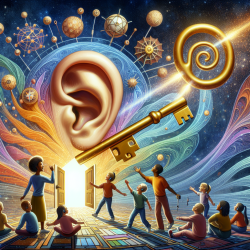Introduction
Auditory Neuropathy Spectrum Disorder (ANSD) presents unique challenges for practitioners, particularly when it comes to speech perception and hearing aid benefits. A recent study, "Audiological Profile of Adult Persons with Auditory Neuropathy Spectrum Disorders," provides valuable insights that can enhance our understanding and treatment approaches for children with ANSD.
Understanding ANSD
ANSD is characterized by normal outer hair cell function but abnormal auditory nerve conduction. This leads to difficulties in speech perception, especially in noisy environments. The study highlights that individuals with ANSD may have preserved cochlear amplification but show asynchronous discharges from the auditory nerve.
Key Findings from the Research
The study involved 38 adults with late-onset ANSD and a control group of 40 normally hearing adults. Key findings include:
- Significant differences in audiological parameters between the ANSD group and normally hearing individuals.
- Variable benefits from hearing aids among the ANSD group, with some showing significant improvement in speech identification.
- Residual temporal processing, particularly amplitude modulation detection, was associated with better outcomes from hearing aids.
Implications for Practitioners
For practitioners working with children with ANSD, these findings underscore the importance of comprehensive audiological assessments. By focusing on temporal processing abilities, practitioners can better tailor interventions to enhance hearing aid benefits. The study suggests that children with residual temporal processing abilities may derive greater benefits from hearing aids.
Encouraging Further Research
While this study provides significant insights, it also opens avenues for further research. Practitioners are encouraged to explore the relationship between temporal processing and hearing aid benefits in children with ANSD. Such research can lead to more effective intervention strategies and improved outcomes for children.
Conclusion
By integrating the findings from this research into practice, practitioners can enhance their ability to support children with ANSD. Understanding the nuances of temporal processing and its impact on hearing aid benefits can lead to more personalized and effective interventions.
To read the original research paper, please follow this link: Audiological Profile of Adult Persons with Auditory Neuropathy Spectrum Disorders.










